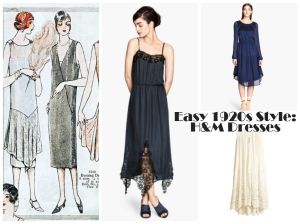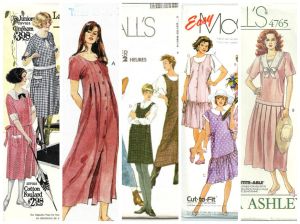We’ve all had that disappointing moment, when, in dressing a period show, we realize how difficult and more so, how expensive authentic period fashion can be.
While one of Bygone’s mandates is to keep our costumes as authentic as possible, in some of my other productions I’ve had to bend the rules and work with modern clothing that mimics the shape and style of period pieces.
In this blog mini-series, I will demonstrate some simple methods for achieving period-esq looks on a budget. If you’ve got some tips of your own, feel free to share them in the comments!
The 1920s Silhouette
Chances are, when most people think of the 1920s, the first image to come to mind is that of the “flapper”. A drop-waist, lots of fringe, knee-length skirt and swinging beads. While this look works for “party girl” characters, or those in a musical, it is not the style that was worn by the majority of women. Still, it is a great stepping stone for a basic women’s silhouette. Let’s examine some basic silhouettes here:
Fig. 1 – Here is a 1920 silhouette from the Fashion-Era website. Early in the decade styles were still fairly conservative. Hemlines reached below mid-calf, exposing no more than the ankles, and empire-waists were still common. Sheath-style, tube-like dresses that gave the women a androgynous look were popular and floppy hats, low on the brow, were often worn (see my blog on hats for more details).
Fig. 2 – Another silhouette courtesy of Fashion-Era , this time from 1922. Note the drop-waist. Flowing, light-weight fabric in the skirt.
Fig. 3 – By the middle of the decade, hemlines were shorter now reaching mid-calf (but still always covering the knee). The drop waist was still fashionable, and the skirts were still often made of flowing fabric.
Fig. 4 – Not an authentic silhouette, but one immediately recognizable as being from the decade. Now the hair is cut short, rather than pinned up, in a style associated with Louise Brooks. Still a drop-waist. Here the skirt seems to be made of fringe or even feathers. The hemline is higher than what would have likely been seen (the knees were rarely revealed).
1920s Colours
The Roaring Twenties saw a wide range of colour in fashion. While only a few decades earlier, most women were wearing dark, dreary colours, the 20’s featured clothing from pastels to bold primary colours. Gowns were generally monochromatic, layering colour-on-colour details and relying on beading or embroidery for variation, rather than mixing colours. This helped to create the long, lean look that was the signature style of the decade.
Fig. 5 – Bold, dark colours for the winter months. Note how the dress itself is nearly entirely one colour – at the very least, monochromatic. A contrasting hat was sometimes worn, and most shoes were black leather.
Fig. 6 – Salmon colours, emerald, and lots of blue. Again, mostly monochromatic although note the high-contrast in the yellow and black gown, and the mixing of natural fur with a bright pastel.
Fig. 7 – More pastel colours for the summer months, and again, blue! Shoes for summer frocks were often of lighter, brighter colours that matched the dress. While there is a lot of detail on the gowns, they continue to be primarily monochromatic.
Fig. 8 – Mixing various shades of the same colour for some visual interest, but still keeping the look monochromatic.
Fig. 9 – Bold, Art Deco inspired styles. Black and white high-contrast gowns with accents in red or pink give a startling, stylized look.
Again, nearly any colour could be used for the 1920s, just remember to avoid any complimentary colours within one outfit for a more authentic look. For additional info, The Vintage Traveler blog has a great post on dating vintage fashion with colour.
1920s Fabrics
A variety of fabrics were available in the 1920s. The majority of things that we purchase today were available then, with the main exception being “stretchy” fabrics (no Lycra in the 20s!). While daily wear was likely simple cotton dresses, I will briefly go over some fabrics that those who do not sew may not be as familiar with:
Chiffon: Made from cotton, silk or synthetic fibers, this sheer, light-weight fabric is woven in a way that puckers the fabric slightly, giving it some stretch and a rough feel. Available in a wide variety of colours it is most common in evening wear and can give an elegant, floating appearance.
Satin: A light-weight, flowing fabric with a glossy front and dull back, satin is another popular formal wear choice. Often associated with nightgowns, this fabric hangs loose and looks stunning when draped. Also available in many colours.
Taffeta: Generally more expensive than the previous two listed, it is a crisp, smooth fabric with a bit of a sheen. Stiff and able to hold some shape, taffeta can be used to create things from corsets, to gowns that maintain a consistent shape. Many colours, but generally less variety (at least in local fabric stores) than the other two, likely due to the cost.
Velvet: A thick, woven, tufted fabric, generally made in deep, dark colours. Smooth and soft, the fabric is associated with nobility and high status, and so the high price tag shouldn’t be a surprise.
I won’t go into too much detail for these, as it is not my area of expertise. However, for a great resource on what fabrics to use, and how to combine them, check out this site.
How-To: 1920s Style in Modern Day Fashion
So what to do with this information now? Certainly those with the budget can source out authentic patterns (Vintage Vogue has a few) and buy expensive fabrics, but when working in community theatre this is rarely an option. To give you an idea of some affordable, modern day pieces that can be used to imitate 1920s fashion, check out my design boards below:

A great resource for affordable dresses is H&M. While the styles you will find here will generally be too short or two revealing to be a really authentic 20s look, there are some dresses that can be a good starting place. Whether you buy a gown that already has a waist, or go for a more loose-fit, flowing style, give the dress a 20s flair by adding an exaggerated drop-waist. A simple way to do this (especially for non-sewers) is to add a sash (remembering to keep it monochromatic!) out of something like satin, tied low on the hips. For those with more sewing knowledge, sleeves could be fashioned out of chiffon or additional beading could be added. Throw on some retro pumps, a few strands of long beaded necklaces, and crop the hair (whether by pinning it up, or cutting it) and you will quickly and cheaply achieve a 20s look.

The community theatre costumer’s best friend is of course, the thrift shop. When trying to create a 1920s look, I generally go for 1980s and 90s fashions. As you can see in the board above, many of the styles of those decades incorporated the drop-waist, as well as large collars, lengthy sleeves, and an overall loose look. You can find these types of dresses in your local value village, or, if you happen to have some old patterns lying around, can make them and tailor them as required.
Finally, online resources like ebay and etsy often have real vintage, or vintage styled clothing. They are worth a look, at least for inspiration, if not to actually purchase the garments. Costume and party stores will often have flapper costumes, but these are generally very stylized and won’t do if you’re trying for a serious period piece. However, the cost is sometimes low, so I keep these in mind for things like dance numbers that require a lot of performers. When trying to do a cheap flapper look, simply create a headband with a feather accent, wear it low on the brow, include a sleeveless, straight-fitting tank top and a low-riding skirt, preferably out of fringe or something that moves. Throw on some cheap plastic beads and voila! Not a look I often need for my shows, but it does in a pinch.
So there you have it! A brief how-to on 1920s women’s fashion for theatre. There are tons of great resources out there, and to be honest, I usually start with a simple google search for my inspiration. Do you have any great 1920s resources? Share them here in the comments, or on our facebook page!
All for now,
E.













2 thoughts on “How to Dress the 1920’s – Affordable Modern Day Alternatives to Authentic 20’s Women’s Fashion”